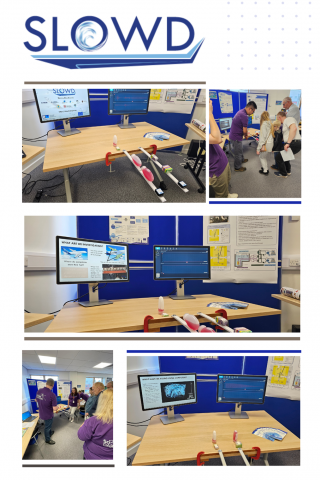More than 5,000 visitors from across the North West gathered at the Science and Technology Facilities Council’s (STFC) Daresbury Laboratory on 15 July 2023, for an awe-inspiring science extravaganza. SLOWD project which was part of the Modelling & Simulation room in the “Computing Zone”, realized a thrilling concept:
Two rulers were firmly clamped to a desk, and each had a Bluetooth accelerometer attached to its end. A number of dry (modelling clay) and wet (coloured water in a clear bottle) masses were then attached to each. The vertical accelerations of the end of each ruler were captured in real-time on a computer screen in the form of a graph.
The public was then told about the SLOWD project, project partners and the funder were explained, and the fact we were exploring how fuel sloshing in an aircraft wing can have a significant effect on flight dynamics. They were invited to “twang” the rulers and see what the natural frequency of the system looked like on the graphs, a large dry mass was then added to the end of one and they were asked what they thought would happen and then to “twang” it again. Once they understood this damped the response of the ruler, an equivalent wet mass was added to the other ruler and they were asked what would happen (most got it right that the rulers would behave the same). Finally, a wet mass with about 50% of the bottle filled was added to one ruler and an equivalent dry mass to the other, again they were asked what would happen. Most guessed that the rulers would behave the same, of course, the sloshing dynamics meant the wet mass ruler was about 50% more damped than the dry mass one. The importance of understanding this effect was then explained in more detail and for those interested, they were given the chance to try different combinations of dry/wet mass on the rulers.
There was a short narrative in the form of a rolling PowerPoint slide deck explaining things and showing SLOWD simulation and experimental results videos which were referred to by those giving the live demo, showing the modelling and simulation results achieved by the project and providing a contextual link from the ruler experiment to the real project.
The event was a perfect opportunity to inspire and engage young visitors in the SLOWD project, sparking their interest in becoming our next generation of scientists, engineers, and technicians.

 This project has received funding from the European Union's Horizon 2020 research and innovation programme under grant agreement No 815044
This project has received funding from the European Union's Horizon 2020 research and innovation programme under grant agreement No 815044